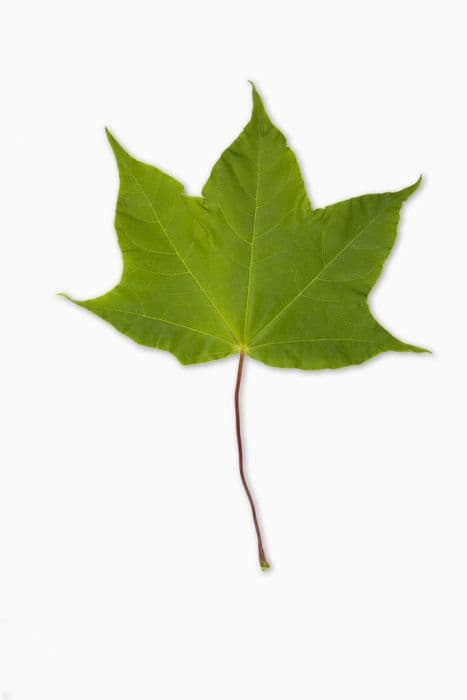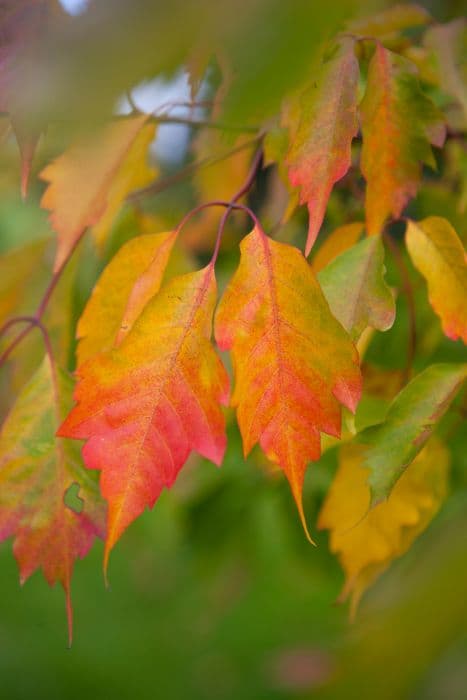Japanese Maple Acer palmatum 'Firecracker' (PBR) (D)

ABOUT
The Japanese Maple 'Firecracker' is a visually striking plant known for its fiery red foliage. The leaves are intricately shaped with multiple pointed lobes that resemble the palm of a hand or an artist's star-shaped brush stroke, lending to the visual drama. In spring, the new leaves burst into a bright red, which can appear almost glowing, as if the tree were alight with a red flame. As the seasons progress, the leaves may transition through a spectrum of colors, from fiery reds to deeper burgundy or purple shades, before shedding in the fall. Adding to the charm are the delicate flowers that may appear in the spring, which are often small and not as prominently displayed as the foliage, but they contribute an additional layer of beauty to this ornamental plant. The bark and branches also present an attractive framework, with a smooth texture and provide a pleasing contrast to the vibrant leaves. Overall, the Japanese Maple 'Firecracker' stands as a stunning specimen known for the brilliance and color it brings to any landscape it graces.
About this plant
 Names
NamesFamily
Sapindaceae
Synonyms
Japanese Maple, Red Japanese Maple, Firecracker Japanese Maple
Common names
Acer palmatum 'Firecracker' (PBR) (D).
 Toxicity
ToxicityTo humans
The Japanese Maple is not considered to be toxic to humans. There are no significant toxic effects reported for ingestion of this plant. However, as with any plant material, individual allergic reactions or irritations are possible.
To pets
The Japanese Maple is generally considered to be non-toxic to pets such as cats and dogs. This plant is not known to cause any serious symptoms of poisoning if ingested by pets. As always, it is advisable to prevent pets from eating plants as a precautionary measure.
 Characteristics
CharacteristicsLife cycle
Perennials
Foliage type
Deciduous
Color of leaves
Varies
Height
6 feet (1.8 meters)
Spread
8 feet (2.4 meters)
Plant type
Tree
Hardiness zones
Varies
Native area
Japan
Benefits
 General Benefits
General Benefits- Visual Interest: Acer palmatum 'Firecracker' offers striking foliage that changes color throughout the seasons, providing a dynamic visual display in the landscape.
- Size: It is a compact tree, suitable for small gardens or spaces where a full-sized maple would be too large.
- Shade Tolerance: The plant can grow in partial shade, making it versatile for different garden conditions.
- Ornamental Bark: The bark of 'Firecracker' can provide winter interest with its texture and color contrast when the leaves have fallen.
- Low Maintenance: Once established, it requires relatively little care beyond occasional pruning to maintain its shape and health.
- Attracts Wildlife: The tree can attract birds and other wildlife that may feed on its seeds or use it for shelter.
- Fall Color: Known for its beautiful autumn hues, the 'Firecracker' can be an excellent choice for creating a focal point in fall landscapes.
- Japanese Garden Aesthetic: Its traditional use in Japanese garden design makes it ideal for creating or complementing an Asian-themed garden space.
 Medical Properties
Medical PropertiesThis plant is not used for medical purposes.
 Air-purifying Qualities
Air-purifying QualitiesThis plant is not specifically known for air purifying qualities.
 Other Uses
Other Uses- Photography: Japanese Maple 'Firecracker' provides a vivid backdrop for photographers, especially in autumn when the foliage turns bright red.
- Feng Shui: Some practitioners may use the plant in Feng Shui designs to introduce fire element colors into a garden, symbolizing energy and enthusiasm.
- Fish Ponds: The canopy can offer shade for fish in a pond, helping to regulate water temperature and provide shelter.
- Bonsai: Its natural tendency to have dense foliage and an interesting branch structure makes it a good option for bonsai enthusiasts.
- Culinary Display: It can be used as a decorative element in food presentation, especially in high-end restaurants, for its elegance.
- Art Classes: Its intricate leaf pattern and seasonal color changes make it an interesting subject for drawing and painting lessons.
- Venue Theming: The trees can be incorporated into event decor for themed parties, such as a "Cherry Blossom" event, providing ambiance.
- Film and Theatre: Used on set to create an East Asian setting or magical forest in films and theatre productions.
- Educational Tool: In schools or botanical gardens, it can be used to teach about plant life cycles and seasonal changes.
- Mood Enhancing: Planted in personal gardens to boost mood through its calming presence and striking visual appeal.
Interesting Facts
 Feng Shui
Feng ShuiThe Japanese Maple is not used in Feng Shui practice.
 Zodiac Sign Compitability
Zodiac Sign CompitabilityThe Japanese Maple is not used in astrology practice.
 Plant Symbolism
Plant Symbolism- Transformation and Change: The Acer palmatum, commonly known as the Japanese Maple, frequently symbolizes transformation and change due to its ability to dramatically change colors with the seasons.
- Peace and Calm: Its serene and graceful form is often associated with peace and tranquility, making it a symbol of calm in the landscape.
- Balanced Beauty: The Japanese Maple's balanced and delicate foliage can represent beauty and elegance, suggesting a sense of harmony and aesthetic perfection.
- Endurance and Strength: Despite its delicate appearance, the Japanese Maple can be quite hardy, symbolizing endurance and the ability to withstand life's challenges.
- Unique Individuality: With numerous cultivars like 'Firecracker' each displaying distinct traits, the Japanese Maple can symbolize individuality and the beauty of being unique.
 Water
WaterJapanese Maple 'Firecracker' requires consistent moisture and should be watered deeply once a week, especially during the summer months to avoid drought stress. Provide the tree with about 10 gallons of water at each watering session, ensuring that the soil is moist but not waterlogged. During the winter, reduce watering to prevent root rot, especially if the soil remains wet for prolonged periods. Always check the soil moisture before watering; the top couple of inches should be dry before you water again.
 Light
LightJapanese Maple 'Firecracker' fares best in a location with partial shade to full sun exposure. Morning sun with afternoon shade is ideal to protect its delicate leaves from scorching. In regions with hotter climates, ensure that the tree is shielded from the intense midday sun to avoid leaf burn.
 Temperature
TemperatureJapanese Maple 'Firecracker' thrives in a climate where temperatures stay between 60°F and 80°F. It can withstand a minimum temperature of approximately -10°F once well established. To encourage ideal growth, protect the tree from harsh winds and place it in a spot where temperature fluctuations are minimized.
 Pruning
PruningPrune Japanese Maple 'Firecracker' to maintain its shape and remove any dead or crossing branches in late winter or early spring before new growth starts. Thinning the canopy to let light into the interior is beneficial. Pruning should be done sparingly as heavy pruning can lead to vigorous regrowth which can alter the natural form of the tree.
 Cleaning
CleaningAs needed
 Soil
SoilJapanese Maple 'Firecracker' thrives in well-drained, sandy loam with high organic content. A mix of one-third topsoil, one-third peat moss, and one-third perlite or pine bark is ideal. The soil pH should be slightly acidic to neutral, around 5.5 to 7.0.
 Repotting
RepottingJapanese Maples like 'Firecracker' typically require repotting every 2-3 years to ensure they are not becoming root-bound and to refresh the soil.
 Humidity & Misting
Humidity & MistingJapanese Maple 'Firecracker' prefers average humidity levels, generally between 40%-60%, avoiding both very dry and overly moist environments.
 Suitable locations
Suitable locationsIndoor
Keep in bright, indirect light; protect from drafts.
Outdoor
Plant in partial shade with shelter from harsh winds.
Hardiness zone
5-8 USDA
 Life cycle
Life cycleJapanese Maple 'Firecracker' begins its life as a seed, which, once sown, germinates in favorable conditions of moisture and temperature. After germination, the seedling grows into a young plant with a small root system and a few leaves, which then develops into a juvenile tree. The juvenile tree goes through a vegetative growth phase, expanding its root system, stem, and foliage, eventually maturing into an adult Japanese Maple 'Firecracker'. This adult tree produces flowers in the spring, which are followed by the development of winged seeds, known as samaras. These seeds are dispersed by the wind, with those landing in suitable environments germinating to complete the cycle. During its lifespan, the Japanese Maple 'Firecracker' undergoes seasonal changes, with leaves turning from green to fiery red or orange in the autumn before shedding, and entering a period of dormancy over winter.
 Propogation
PropogationPropogation time
Late winter
Propogation: The Japanese Maple 'Firecracker' can be propagated most commonly through softwood cuttings. This technique typically takes place in early summer when new growth is still flexible but starting to mature. The process involves taking a 4 to 6-inch cutting (about 10 to 15 cm) from a healthy parent plant, making sure it has at least two sets of leaves. The lower leaves are removed, and the cut end is often dipped in a rooting hormone to stimulate root growth. The cutting is then planted in a well-draining soil mix, kept moist, and placed in a warm location with indirect sunlight. A plastic bag or a propagator can be used to maintain high humidity around the cutting. Roots generally develop within a few weeks, after which the new plant can be gradually acclimatized to less controlled conditions.









